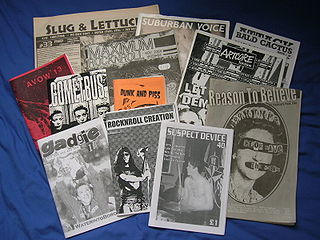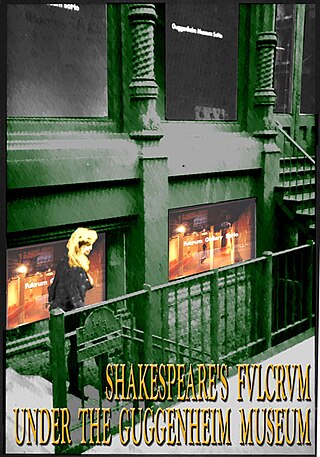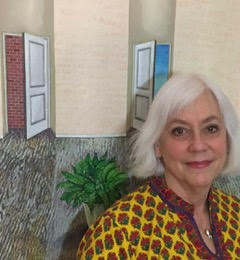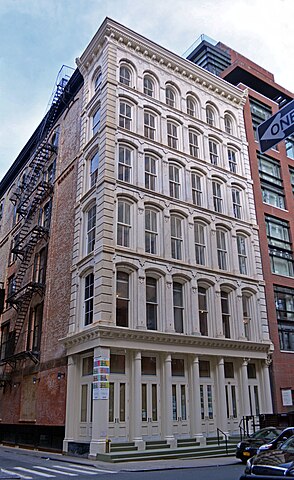
Dan Flavin was an American minimalist artist famous for creating sculptural objects and installations from commercially available fluorescent light fixtures.

Robert Gober is an American sculptor. His work is often related to domestic and familiar objects such as sinks, doors, and legs.

Punk visual art is artwork associated with the punk subculture and the no wave movement. It is prevalent in punk rock album covers, flyers for punk concerts and punk zines, but has also been prolific in other mediums, such as the visual arts, the performing arts, literature and cinema. Punk manifested itself "differently but consistently" in different cultural spheres. Punk also led to the birth of several movements: new wave, no wave, dark wave, industrial, hardcore, queercore, etc., which are sometimes showcased in art galleries and exhibition spaces. The punk aesthetic was a dominant strand from 1982 to 1986 in the many art galleries of the East Village of Manhattan.
Lance Fung Gallery (1996-2003) was an art gallery of contemporary art once located at 537 Broadway in New York City where it shared an exhibition space with the Emily Harvey Gallery.
Vincent Como is a Brooklyn-based visual artist. His work is rooted in Minimalism, Conceptual Art, and Color Field Painting with a specific focus toward Black. Como has referenced the influence of Ad Reinhardt and Kasimir Malevich, as well as movements such as the Italian Arte Povera movement from the 1960s.

Fulcrum Gallery was an American art gallery that opened underneath the Guggenheim Museum SoHo in New York City in January 1993, by Valerie Monroe Shakespeare. It was designed by her husband, Tery Fugate-Wilcox, who contributed the gallery motto: "Without Art we are but Monkeys with Car Keys". Fugate-Wilcox is credited as photographer on all of the gallery's ads, and was listed as one of the nineteen artists represented by the gallery. The owner said in an interview, that the name "Fulcrum", came from Archimedes, "Give me a place to stand, a lever long enough and a fulcrum. and I can move the Earth". She said she hoped Fulcrum would become a "pivotal point in art history". Fulcrum Gallery was founded to exhibit Actual Art exclusively and did so until the effects of the attacks of 9/11 caused the gallery to close in February 2002.
Brian Christopher Rutenberg is an American abstract painter.
The Pictures Generation, 1974–1984 was an exhibition at The Metropolitan Museum of Art in New York City that ran from April 29 – August 2, 2009. The exhibition took its name from Pictures, a 1977 five person group show organized by art historian and critic Douglas Crimp (1944–2019) at New York City's Artists Space gallery. The artists exhibited from September 24 to October 29, 1977 were Troy Brauntuch, Jack Goldstein, Sherrie Levine, Robert Longo and Philip Smith.
Christopher D’Arcangelo was an American artist who worked in the 1970s until his death in 1979. He was the son of the American painter Allan D'Arcangelo.

Howardena Pindell is an American artist, curator, critic, and educator. She is known as a painter and mixed media artist who uses a wide variety of techniques and materials. She began her long arts career working with the New York Museum of Modern Art, while making work at night. She co-founded the A.I.R. Gallery and worked with other groups to advocate for herself and other female artists, Black women in particular. Her work explores texture, color, structures, and the process of making art; it is often political, addressing the intersecting issues of racism, feminism, violence, slavery, and exploitation. She has created abstract paintings, collages, "video drawings," and "process art" and has exhibited around the world.
Claudia Gould is an art curator and former Helen Goldsmith Menschel Director of The Jewish Museum in New York City.

Catherine de Zegher is a Belgian curator and a modern and contemporary art historian. She has a degree in art history and archaeology from the University of Ghent.
Helene Winer is an American art gallery owner and curator. She co-owned Metro Pictures Gallery in New York City with Janelle Reiring. Metro Pictures closed in late 2021. Her career deeply involved the postmodern artists of the 1970s and 1980s known as the Pictures Generation. She lives in Tribeca.

Janet Henry is a visual artist based in New York City.

Robin Tewes is a Queens-born, New York City-based artist, known since the early 1980s for her representational paintings of frozen, narrative-like moments. She has shown her work in numerous solo exhibitions in New York City, as well as nationally and internationally, and exhibited at venues including P.S. 1, the Museum of Modern Art, the Whitney Museum, The Drawing Center, and the Central Academy of Fine Arts (Beijing), among many. Her work has been widely discussed in publications including Artforum, Art in America, ARTnews, Tema Celeste, the New York Times, the Los Angeles Times, and the Village Voice. Tewes was a founding member of the P.S. 122 Painting Association. She has been recognized with a Pollock-Krasner Foundation Fellowship (2015) and Painting Award (2008), an Adolph and Esther Gottlieb Foundation Award (2007), and inclusion in the Smithsonian Archives of American Art in 2016.
Momenta Art was an artist-run, not-for-profit organization and gallery, which from its founding in 1986 to its closing in 2016, exhibited and promoted emerging artists and underrepresented artistic perspectives. Artists who received support from Momenta Art include Simone Leigh, Chitra Ganesh, Elana Herzog, and Mark Tribe.

Cameron Rowland is an American conceptual artist whose work has been exhibited internationally and acclaimed for its structural analytic approach to addressing issues of American slavery, mass incarceration, and reparations. Rowland graduated from Wesleyan University in 2011 and they were awarded the MacArthur Fellowship in 2019 after several solo and group exhibitions at venues including the Museum of Modern Art, Whitney Museum of American Art, Kunsthal Aarhus, and La Biennale de Montreal. Rowland is noted for their distinct method of loaning some works to collectors and institutions rather than selling them outright, an approach meant to mirror the experience of low-income people shopping at rent-to-own stores like Rent-A-Center and disrupt the traditional value structure in the contemporary art market.

A number of real-life and virtual reality exhibits of Vincent van Gogh's paintings have been staged around the world since the 2000s. The for-profit events range across venues, organizers, and locations, though the majority have been held in North America in 2021 and 2022. The events are typically set up in large gallery spaces. Images or videos of the artist's works are projected onto walls, ceilings, and floors, sometimes accompanied by animations, narrations, music, or fragrances.
Daniel S. Palmer is an American curator and art historian. Palmer is currently Chief Curator at the SCAD Museum of Art. He was previously the Curator at Public Art Fund, New York, where he organized 18 exhibitions from 2016 to 2022. Before that, he held the position of the Leon Levy Assistant Curator at the Jewish Museum, New York and was a curatorial research assistant at the Whitney Museum of American Art. He received his PhD in Art History from the CUNY Graduate Center in 2021. He also holds a M.Phil in Art History from the CUNY Graduate Center and a BA degree from Rutgers University.

The Cinque Gallery (1969–2004) was co-founded by artists Romare Bearden, Ernest Crichlow, and Norman Lewis as an outgrowth of the Black power movement to "provide a place where the works of unknown, and neglected artists of talent …" — primarily Black artists — "would not only be shown but nurtured and developed". "Relying on a series of volunteers, Cinque hosted solo, group, and touring exhibitions," and sponsored an artist-in-residence program, which was inaugurated with collagist Nanette Carter.











